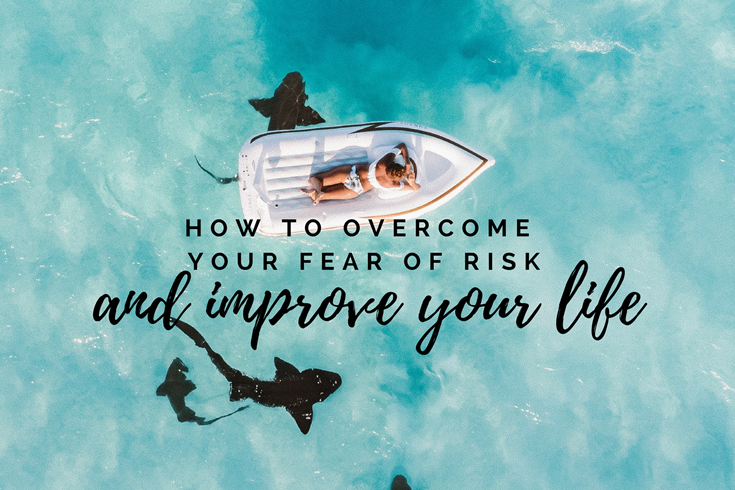|
|
Risk is something that can instill fear in all of us. The risk of rejection, the risk of failure, and so on and so on.
My clients often express fear of starting something new in their careers. My friends are sometimes afraid of making a major life change. I too have experienced fear of certain risks.
I’ve had several people say to me they admire the fact that I wasn’t afraid to risk traveling to the other side of the world by myself, risk ending a sub-par relationship, or risk starting my own business.
I never said I wasn’t afraid to do those things. There was some fear involved in all those things because each of them came with certain risks.
It wasn’t about being unafraid.
It was about pushing through and overcoming the fears in order to get to something better in my life.
7 Ways to Overcome Your Fear of Risk and Improve Your Life
A couple of years ago I read an article entitled “7 Ways to Control Your Fear and Advance Your Career” by bestselling author Harvey Mackay.
The seven things he outlined can be applied to any area of your life, not just your career.
I’d like to expand on the seven things he mentioned, but I’m going to slightly change the order of them.
1. Try new things.
Yes, you’ve heard me say that more than once. But, it’s always worth repeating.
Why? Because there are always new things to try.
And you never know what new thing is going to become the thing that gets you over your fears and improves your life until you try.
Mackay says,
“There is only one thing worse than a quitter, and that is someone who is afraid to begin…Never be afraid to try something new. Remember, amateurs built the ark. Professionals built the Titanic. Think about it.”
Trying new things will lessen future fears, build your confidence, and increase your ability to handle future risks.
So, let me ask you the same question Darius Rucker is asking in his hit song,
When was the last time you did something for the first time?
2. Review your risks
If taking future risks will help you overcome your fear and build your confidence, then certainly any past risks you’ve taken and fears you’ve already faced have built a certain level of confidence in you.
Spend some time reviewing all the times you’ve stepped out of your comfort zone or done something you were afraid of.
What was the result?
How did you feel after you did it?
Even if it failed, what was the biggest lesson you learned from it?
What was successful about the experience?
How did it help you overcome fear?
Chances are the outcome wasn’t as bad as you thought it was going to be and most of the risks you took turned out to be okay.
Mackay says,
“Figure out what made them work. Can you duplicate those decisions that led to success and apply them to other situations?”
3. Explore your memories
Since you’re already looking back, take some time to also look back over your life and career to explore what exactly instills fear in you.
What do those situations look like?
What are their common denominators?
What happened when you were afraid to do something but did it anyway?
4. Look at your responsibilities
Regardless of your age, marital status, work situation, etc., you have a lot of priorities and responsibilities in your life.
Sometimes I think my friends who are married with children assume I’m not as busy as them or don’t have as many responsibilities, but it’s not true. I just have a different set of responsibilities and pressures.
As a single person who owns and runs her own business, I have a lot of pressures on me to get everything done without the help of a partner (or children old enough to earn an allowance). All the household responsibilities fall on me, and all the finances and expenses are covered by only one income.
It’s my name and reputation that’s at stake when something goes wrong in the business. The business is sometimes like a baby in that, on some days, it’s a never-ending 24–7 job.
Your challenges might be the same or might be totally different.
You can’t compare your situation to someone else’s because it’s likely you’ll be comparing apples to oranges.
Just look at your own responsibilities.
Which ones make you feel afraid or anxious?
Why are you afraid of them?
Keep digging and ask “why” until you’ve discovered the root of your fear.
5. Construct a worst-case scenario
Mackay says,
“When a certain situation makes you nervous, try to think of the worst thing that could realistically happen. Chances are the reality won’t be as devastating as you think, and examining the possibilities ahead of time will prepare you to avoid the potential pitfalls.”
Yes, I agree, it is good to do this.
However, if you’re the type of person who already has a bad habit of immediately going to the worst-case scenario, I suggest limiting the amount of time you spend constructing the worst-case scenario.
Instead, spend your energy shifting your focus, as described in #6.
6. Shift your focus
After you construct a worst-case scenario, you want to shift your focus to potential best-case scenarios.
Think about all the possible benefits and positive by-products of facing your fear.
By focusing on the potential positive outcomes, you reduce your anxiety and worry less.
7. Expect your fears to occasionally resurface
Mackay says to accept the fact that there will still be times when you feel fear or a lack of control.
This is true. There are still things that cause me to panic or become afraid. But because I’ve faced my fears in the past, new fears don’t have as strong of a grip on me now days.
Prepare yourself as best you can (by using the tips above and the ones in the related posts listed below) to handle potential risks that may cause anxiety or fear.
Mackay’s Moral:
“Don’t let your fears get in your head — get ahead of your fears.”
Once you begin to overcome some of your fears, you’ll be eager and ready to set more goals for yourself.
And if you want to not just set goals but achieve them, I invite you to subscribe to my newsletter. When you do you’ll receive a complimentary 8-Step Goal-Achievement Plan.
Related Posts:
- How to Make the Risk of Starting Your Own Business Doable
- How to Hack Your Way to a More Passionate Life and Career
- When Was the Last Time You Challenged Your Limits?
- 10 Lessons I’ve Learned From 10 Years of Freelancing
- Make 2018 the Year of the Right Regrets
- How to Have a Good Life: Do These 7 Small Things






